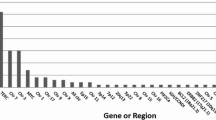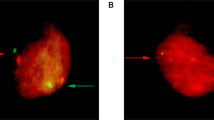Abstract
Background and objectives: Cervical cancer is the most common cancer in Indian women and is a leading cause of death in women worldwide. Cervical cancer develops from pre-neoplastic cervical intraepithelial neoplasia (CIN). This study was conducted to evaluate telomerase activity as a tumor marker for the detection of cancer in patients with CIN and cervical cancer. The results were compared with human papillomavirus (HPV) status, clinical staging, and histopathologic studies.
Methods: Telomerase activity was detected using the PCR-based telomeric repeat amplification protocol (TRAP) assay in cervical tissues collected by routine punch biopsy from the uterine cervix of patients with suspected cervical cancer. High-risk (HR) HPV-16 and -18 status was determined in all the study groups, including controls. A total of 125 patients (including 50 patients with CIN and 75 patients with cervical cancer [including nine patients with adeno-squamous disease]) and 22 control subjects were studied. The sensitivity and specificity for detecting CIN and cervical cancer were calculated.
Results: Patients with grade I, II, and III CIN showed 17%, 33%, and 57% positivity for telomerase, respectively. In patients with cervical cancer, those at early clinical stages (Ia-IIb) showed 68% positivity and those at later clinical stages showed 92% positivity for telomerase activity. In the present study, telomerase positivity correlated significantly with the detection of HR HPV-16 and -18 (p < 0.001). As a diagnostic test, none of the described analyses combined a sensitivity of ≥90% with a specificity of ≥90%, except in patients with advanced cancer when telomerase activity was used as a diagnostic test.
Conclusion: Our findings suggest that telomerase activation is a relatively early event in cervical carcinogenesis and correlates with the grade of cervical lesion, HR-HPV status (16 and 18 subtypes), and clinical staging. Hence, these associations suggest it as a possible target for detection of cervical cancer.









Similar content being viewed by others
References
National Cancer Registry Programme. Consolidated report of the population based cancer registries. New Delhi: ICMR, 1996: 61
Herrero R. Epidemiology of cervical cancer. Natl Cancer Inst Monogr 1996; 21: 1–6
Pisani M, Parkin DM, Ferlay J. Estimates of the worldwide mortality from eighteen major cancers in 1985: implications for prevention and projections of future burden. Int J Cancer 1993; 55: 891–903
Pinto AP, Cram CP. Natural history of cervical neoplasia: defining progression and its consequences. Clin Obstet Gynaecol 2000; 43: 352–62
Ault KA, Allen HK, Phillips SL, et al. Telomerase activity as a potential diagnostic marker for triage of abnormal Pap smears. J Low Genit Tract Dis 2005; 9: 93–9
Bravaccini S, Sanchini MA, Amadori A, et al. Potential of telomerase expression and activity in cervical specimens as a diagnostic tool. J Clin Pathol 2005; 58: 911–4
Reddy VG, Khanna N, Jain SK, et al. Telomerase: a molecular marker for cervical cancer screening. Int J Gynecol Cancer 2001; 11: 100–6
Blackburn EH. Structure and function of telomeres. Nature 1991 Apr 18; 350(6319): 569–73
Zheng PS, Iwasaka T, Zhang ZH, et al. Telomerase activity in Papanicalou smear-negative exfoliated cervical cells and its association with lesions and oncogenic human papilloma viruses. Gynecol Oncol 2000; 77: 394–8
Reesink Peters N, Helder MN, Wisman GBA, et al. Detection of telomerase, its components and human papilloma virus in cervical scrapings as a tool for triage in women with cervical dysplasia. J Clin Pathol 2003; 56: 31–5
Lowry OH, Rosebrough NJ, Farr AL, et al. Protein measurement with the Folin-Phenol reagent. J Biol Chem 1951; 193: 265–75
Kim NW, Piatyszak MA, Prowse KR, et al. Specific association of human telomerase activity with immortal cells and cancer. Science 1994; 266: 2011–4
Kyo S, Kanaya T, Ishikawa H, et al. Telomerase activity in gynaecological tumors. Clin Cancer Res 1996; 2: 2023–8
Boom R, Sol CJA, Salimans MMM, et al. Rapid and simple detection method for purification of nucleic acids. J Clin Microbiol 1990; 28: 495–503
Smits HL, Tieben LM, Tjong-A-Hung SP, et al. Detection and typing of human papilloma viruses present in fixed and stained archival cervical smears by a consensus polymerase chain reaction and direct sequencing allow the identification of a broad spectrum of human papilloma viras types. J Gen Virol 1992; 73: 3263–8
Tieben LM, ter Schegget J, Minaar RP. Detection of cutaneous and genital HPV types in clinical samples by PCR using consensus primers. J Virol Methods 1993; 42: 265–80
Wisman GB, de Jong S, Meersma GJ, et al. Telomerase in (pre)neoplastic cervical disease. Hum Pathol 2000; 31: 1304–12
Zheng PS, Iwasaka T, Yamasaki F, et al. Telomerase activity in gynecologic tumors. Gynaecol Oncol 1997; 64: 171–5
Zheng PS, Iwasaka T, Yokoyama H, et al. Telomerase activation in in vitro and in vivo cervical carcinogenesis. Gynecol Oncol 1997; 66: 222–6
Iwasaka T, Zheng PS, Yokoyama H, et al. Telomerase activation in cervical neoplasia. Obstet Gynecol 1998; 91: 260–7
Healy KC. Telomerase dynamics and telomerase activation in tumor progression: prospects for prognosis and therapy. Oncol Res 1995; 7: 121–30
Wang SZ, Sun JH, Zhang W, et al. Telomerase activity in cervical intraepithelial neoplasia. Chin Med J (Engl) 2004; 117: 202–6
Wisman GBA, Knol AJ, Helder MN, et al. Telomerase in relation to clinicopathologic prognostic factors and survival in cervical cancer. Int J Cancer 2001; 91: 658–64
Schaffer P, Sancho-Garnier H, Fender M, et al. Cervical cancer screening in France. Eur J Cancer 2000; 36: 2215–20
Sen S, Reddy VG, Guleria R, et al. Telomerase: a potential molecular marker of lung and cervical cancer. Clin Chem Lab Med 2002; 40: 994–1001
Herbsleb M, Knudsen UB, Orntoft TF, et al. Telomerase activity, MIB-1, PCNA, HPV 16 and p53 as diagnostic markers for cervical intraepithelial neoplasia. APMIS 2001; 109: 607–17
Zhang DK, Ngan HY, Cheng RY, et al. Clinical significance of telomerase activation and telomeric restriction fragment (TRF) in cervical cancer. Eur J Cancer 1999; 35: 154–60
Kyo S, Takakura M, Tanaka M, et al. Telomerase activity in cervical cancer is quantitatively different from that in its precursor lesions. Int J Cancer 1998; 79: 66–70
Yashima K, Ashfaq R, Nowak J, et al. Telomerase activity and expression of its RNA component in cervical lesions. Cancer 1998; 82: 1319–27
Jarboe EA, Liaw KL, Thompson LC, et al. Analysis of telomerase as diagnostic marker of cervical dysplasia and carcinoma. Oncogene 2002; 21: 664–73
Nowak JA. Telomerase, cervical cancer and human papilloma virus. Clin Lab Med 2000; 20: 369–82
Isaka K, Nishi H, Osakabe Y, et al. Establishment of a HPV and p53-mutation-negative human cell line derived from a squamous carcinoma of the cervix. Gynecol Oncol 2004; 92: 15–21
Pao CC, Tseng C, Yang F, et al. Differential expression of telomerase activity in human cervical cancer and cervical intraepithelial neoplasia lesions. J Clin Oncol 1997; 15: 1932–7
Jarboe EA, Thompson LC, Heinz D, et al. Telomerase and human papilloma virus as diagnostic adjuncts for cervical dysplasia and carcinoma. Hum Pathol 2004; 35: 396–402
Tsezou A, Oikonomou P, Kollia P, et al. The role of human telomerase catalytic subunit mRNA expression in cervical dysplasias. Exp Biol Med 2005; 230: 263–70
Helder MN, de Jong S, de Vries EGE, et al. Telomerase targeting in cancer treatment: new developments. Drug Resist Updat 1999; 2: 104–15
Novakovic S, Fras PA, Jezersek-Novakovic B. Telomerase activity as a biological marker in some gynaecological tumors. In Vivo 2001; 15: 327–32
Norton JC, Piatyszek MA, Wright WE, et al. Inhibition of human telomerase activity by peptide nucleic acids. Nat Biotechnol 1996; 14: 615–9
Kondo S, Tanka Y, Kondo Y, et al. Antisense telomerase treatment induction of two distinct pathways, apoptosis and differentiation. FASEB J 1998; 12: 801–11
Kondo Y, Kondo S, Tanaka Y, et al. Inhibition of telomerase increases the susceptibility of human malignant glioblastoma cells to cisplatin induced apoptosis. Oncogene 1998; 16: 2243–8
Pitts AE, Corey DR. Inhibition of human telomerase by 2′-O-methyl-RNA. Proc Natl Acad Sci U S A 1998; 95: 11549–54
Acknowledgments
We thank Dr B.C. Das and Dr Uma Kailash, Institute of Cytology and Preventive Oncology, New Delhi, India, and Dr Raksha Arora, Department of Obstetrics and Gynecology, Maulana Azad Medical College and Associated Hospitals, New Delhi, India, for their help during the course of this study.
We are particularly indebted to the patients who agreed to participate in this study. The financial support provided by the Indian Council of Medical Research, New Delhi is gratefully acknowledged. The authors have no conflicts of interest that are directly relevant to the content of this study.
Author information
Authors and Affiliations
Rights and permissions
About this article
Cite this article
Sharma, A., Rajappa, M., Saxena, A. et al. Telomerase Activity as a Tumor Marker in Indian Women with Cervical Intraepithelial Neoplasia and Cervical Cancer. Mol Diag Ther 11, 193–201 (2007). https://doi.org/10.1007/BF03256241
Published:
Issue Date:
DOI: https://doi.org/10.1007/BF03256241




